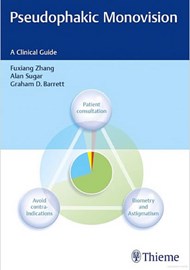The contents of this small volume should provide useful tips for all ophthalmic practitioners involved with managing patients undergoing cataract surgery. For those ophthalmic clinicians and supporting staff not familiar with the potential options for achieving a spectacle independent refractive outcome following cataract surgery, this book provides a useful introduction and an overview.
The book is organised into seven chapters, including ‘The Optics’ and ‘Neurophysiology of Pseudophakic Monovision’, ‘Non-Pseudophakic Monovision’ and ‘Special Situations’. ‘The Optics’ section includes a few simple diagrams and the explanations should be readily comprehended without a higher qualification in mathematics. A chapter on ‘Ocular Co-morbidities and Pseudophakic Monovision’, comprises a series of case reports illustrated by quality Humphrey visual field plots and Spectralis OCT scans. The references are comprehensive for each chapter, including UK-originated research articles.
The most extensive chapter is predictably devoted to ‘Pseudophakic Monovision’. There are various scenarios presented which consider how the impact of sighting and sensory dominance, and current and proposed anisometropia can influence the likelihood of achieving spectacle independence using this technique. Monovision is known to have a negative impact on contrast sensitivity, stereopsis and fusion, so those requiring high levels of fine stereopsis for their work are not ideal candidates for this option. Suggestions are given for managing unexpected refractive outcomes, however, the authors do include a word of caution that the effects on fine stereopsis may not be fully reversible.
Emphasis is placed on the importance of adequate pre-surgery discussions with prospective patients to establish appropriate levels of post-op expectations by identifying ‘Priority Goals’ when spectacle independence is desired and monovision is proposed. This book explores the potential pitfalls and guidance regarding selection of monofocal intraocular lenses (IOLs) or the alternative modern designs including accommodating IOLs, extended depth of focus IOLs, multifocal IOLs, toric IOLs and liqht-adjustable IOLs. In-depth discussions are inevitably time-consuming and it is debatable whether a customised approach can be achieved within the constraints of the current NHS budget.
Unfortunately, a couple of the photographs failed to demonstrate a fundamental principle, that of accurate centration of corrective optical devices. This aspect should not be ignored in practice as it is likely to compromise comfortable, optimal vision and applies to any spectacle lens, contact lens or indeed intraocular lens.
Access to additional media content with the print version and e-book version is possible by entering an access code at MedOne.thieme.com/code and registering on that site.
It is common practice nowadays to allow access to online material for the buyer’s private use although library copies can permit access to authorised users. Inevitably this applies restrictions on sharing copies of such publications.




